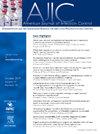Effectiveness of a multimodal strategy to reduce external ventricular drain–associated infection: A quasi-experimental study
IF 3.8
3区 医学
Q2 INFECTIOUS DISEASES
引用次数: 0
Abstract
Background
Infection is a serious complication in neurosurgical patients who undergo external ventricular drain (EVD) insertion.
Methods
We conducted a quasi-experimental study in patients who underwent EVD insertion to evaluate the impact of a multi-modal strategy to reduce the incidence of external ventricular drain associated infections (EVDAIs). The study was divided into 2 periods; (1) the pre-intervention period when techniques for EVD insertion and maintenance were up to the discretion of the neurosurgeons and (2) the post-intervention after implementation of a multi-modal strategy (cefazolin antibiotic prophylaxis, preoperative chlorhexidine showers, application of postoperative chlorhexidine-impregnated dressing, limited manipulation of the EVD, and meticulous EVD management). The primary outcome was the incidence rate of EVDAIs; secondary outcomes included in-hospital mortality rate, the hospital length of stay.
Results
In total, 135 patients were included. The incidence rate of EVDAIs was significantly reduced in the post-intervention period (5.6 cases/1,000 EVD-days) compared with the pre-intervention period (18.2 cases/1,000 EVD-days; P=0.026). There were no differences in all secondary outcomes analyzed. This multi-modal strategy was associated with high satisfaction among health care personnel.
Conclusions
Implementation of a multi-modal strategy was associated with a reduction in the incidence of EVDAIs. This was in line with our goal of promoting a new culture of safety despite being in a resource-limited setting.
减少室外引流相关感染的多模式策略的有效性:准实验研究
背景:感染是接受脑室外引流管插入术(EVD)的神经外科患者的一种严重并发症,与高发病率和高死亡率相关:我们对接受脑室外引流管插入术的患者进行了一项准实验研究,以评估降低脑室外引流管相关感染(EVDAIs)发生率的策略的影响。研究分为两个阶段:(1) 干预前阶段,EVD插入和维护技术由神经外科医生自行决定;(2) 干预后阶段,实施多模式策略(头孢唑啉预防、术前洗必泰冲洗、术后使用洗必泰浸渍敷料、限制操作EVD以及进行细致的EVD管理)。主要结果是 EVDAI 的发生率;次要结果包括院内死亡率和住院时间:结果:共纳入 135 名患者。与干预前(18.2 例/1,000 个 EVD 日;P=0.026)相比,干预后 EVDAI 的发生率明显降低(5.6 例/1,000 个 EVD 日)。所有次要分析结果均无差异。医护人员对这一多模式策略的满意度很高:结论:多模式策略的实施与 EVDAI 发病率的降低有关。这符合我们的目标,即在资源有限的环境中促进新的安全文化。
本文章由计算机程序翻译,如有差异,请以英文原文为准。
求助全文
约1分钟内获得全文
求助全文
来源期刊
CiteScore
7.40
自引率
4.10%
发文量
479
审稿时长
24 days
期刊介绍:
AJIC covers key topics and issues in infection control and epidemiology. Infection control professionals, including physicians, nurses, and epidemiologists, rely on AJIC for peer-reviewed articles covering clinical topics as well as original research. As the official publication of the Association for Professionals in Infection Control and Epidemiology (APIC)

 求助内容:
求助内容: 应助结果提醒方式:
应助结果提醒方式:


